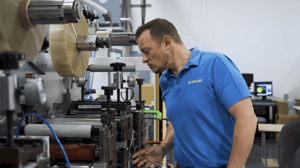Even though you're excited about your new product design, you're unsure how to bring it to life.
Few things are more satisfying than turning raw material into a finished product. While raw materials have potential, they aren’t easily usable on their own.
Strouse specializes in transforming customer designs into accurate and usable components as a material converter. To help you understand and prepare for the future, we’ll cover the definition of adhesive converting and discuss the role of converting in product development.
What is an Adhesive Tape Converter?
An adhesive converter typically takes large rolls of raw material — tape, films, paper, plastic, foam, soft metals, and more — and “converts” them into usable parts.
As advanced as the materials themselves may be, the large, continuous rolls (called master rolls) provided by an adhesive manufacturer (like 3M) are of practically no use to customers; they’re too large to handle, not the right shape or size, and the material isn’t finished the way it needs to be.
One of the best analogies for adhesive converting is your local baker. They buy raw ingredients — flour, sugar, salt, milk, eggs, etc. — and often don’t make the ingredients themselves. However, they know the market and the best vendors to get those ingredients.
While sugar is essential, most customers don’t satisfy their sweet tooth by consuming raw sugar. Instead, the baker turns those raw materials into delicious baked goods for their customers.
Similarly, adhesive tape converters don't necessarily make their own adhesives, foams, films, paper, plastic, soft metals, etc. However, top-end converters are very familiar with the market, so they know virtually all the flexible material manufacturers that make these materials. They’re uniquely superior at sourcing the right materials and turning them into customers' desired products.
DIFFERENT WAYS TO CONVERT MATERIALS
Adhesive tape converters possess many in-house manufacturing capabilities, from slitting a single material to laminating multiple materials to create a unique product.
An adhesive converter processes materials with flat bed, rotary, or laser cutting methods to create a custom-sized and shaped product that meets the customer’s needs. Adhesive converters may also combine thin bonding adhesive tapes with other materials (polyesters, foams, felts, etc.) to create specialized solutions.
Above all else, a converter will work closely with application engineers to select a suitable adhesive product and optimize your design to meet the unique needs of your solution.
How is Converting Crucial to the Product Development Process?
Converting large rolls of adhesive into a final product requires collaboration between you and your converter’s engineers. Together, they can determine the most cost-efficient and manufacturable properties and dimensions of each adhesive product.
Choosing the right converter may take careful planning, but it can also effectively determine the quality of your product. At first, choosing an adhesive converter may seem nearly as difficult as developing the product solution— but it doesn’t have to be. Your ideal converter should:
1) Remain dedicated from the project’s beginning to the end
2) Show proven problem-solving skills
3) Have the necessary industry connections
4) Keep the project’s budget top-of-mind at all times
If you’re looking for a custom product solution, consider scheduling a project consultation and starting the journey toward getting your part or roll in hand.
Your initial meetings with a converter before production will cover tolerance levels, the method of adhesive application, and the environment in which the product must perform (humidity, temperature, and UV rays can affect an adhesive’s effectiveness). All of this information will help inform the best types of materials and processes to build your design.
Creating a custom product is no easy feat, but with the help of an adhesive tape converter, you can successfully excel in your project development process. To learn more about adhesive converters, consider checking out our Learning Center for more specific information with examples.
Originally published: July 28, 2021







